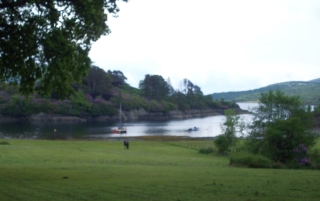Despite having walked, climbed and now sailed in and around Scotland I had always assumed that the term 'Highlands' was a man-made construct conceived purely for administrative or political convenience. Until, that is, we came across this sign just outside Rothesay on the Isle of Bute which lies on the Highland Boundary Fault. This is a geological phenomenon which divides the 'Old Red Sandstone from the Metamorphic and Archaean deposits' [Thank you Wikipedia]. Aligned southwest to northeast, from Lochranza on the Isle of Arran the fault bisects Bute, continues up the Firth of Clyde, coming ashore near Helensburgh. It then passes through Loch Lomond and eventually reaches the North Sea close to Stonehaven. Without realising it, we find that on our travels we have visited both the landward ends of a vast geological statement on the earth's crust.
None of which would have had much significance to the first inhabitants of Holy Island, a small mountainous lump just off the east coast of Arran, nor even to Saint Molaise who in the 6th century dispensed justice from a well-appointed cave on its western shore. Since 1992 this place has been inhabited by Buddhist monks and now boasts the Tibetan Buddhist Centre for World Peace and Health. 'Respect life and refrain from killing; respect other's property and refrain from stealing; encourage health and refrain from intoxicants; speak only the truth; refrain from sexual activity that causes harm' are the five rules that Lama Yeshe Losal Rinpoche asks the island's visitors to observe. So swiftly running down the list and deciding that none of these would cause us any problems, we tossed Cirrus' anchor overboard just a stone's throw from the island's west flank and watched it bury itself into the bottom three metres below.
To be honest, all we rather desperately wanted was a good night's sleep as for the previous two we had been on a mooring in Arran's Lamlash Bay where the sea had thrown us about all night. We had been out of bed countless times adjusting our mooring ropes, to suit the sudden north-easterly wind which brought long swells into the bay. Our bodies were shaken continuously as we lay trying to sleep, shuffled forward and back as our boat plunged headfirst into the waves then from side to side when she turned edge on to the rollers. After clear days spent fending off sunburn and long evenings admiring stunning sunsets until well after 10 'o clock we had rather taken it for granted that a peaceful night's sleep would follow.
But no such luck. Had we known, of course, that just across the bay we could snuggle up to Holy Island's stony beach and find relative calm then we would have been there like a shot but it takes time to acquire such local knowledge and we are still strangers here.
But no such luck. Had we known, of course, that just across the bay we could snuggle up to Holy Island's stony beach and find relative calm then we would have been there like a shot but it takes time to acquire such local knowledge and we are still strangers here.
Holy Island's monks don't have the place all to themselves as they share with flocks of Soay sheep, small brown things with long thin legs that make them look more like cartoon images of sheep than the real thing, and white-fleeced goats. Eriskay ponies also run wild wherever they please and in a small pond these tadpoles had clearly been spending their time in meditation instead of making themselves into frogs as mainland tadpoles would have done many weeks ago.
The monks indulge their artistic inclinations by carving and painting some of the larger exposed boulders that litter the landscape, creating brilliantly coloured images which peep out from the surrounding ferns in a cheeky sort of way. Visitors to the island are encouraged to respect all these things and such is the atmosphere of the place that, strangely enough, they do. A footpath leads to the island's thousand foot summit where, on the top of the concrete trig point, many have left money, coins, exposed to the wind and rain. Some people might drop coins in a fountain as a misguided way to secure personal fortune but this is rather different, I feel, as this money is intended as a gift to the island's inhabitants. Some magic has permeated this place and its spell infects those who come here. And long may it continue.
Two peaceful nights we spent in the lea of this place, quiet evenings where the whinny of a horse or the bleat of sheep carried across to us as the sun set. All the while our anchor chain quietly scooped up kelp from the bottom so that when we tried to bring it back on board a massive load of the stuff came up with it, pulling the bow down until we could reach over and ease each piece off. A brief sail across the Firth of Clyde has taken us to Troon where we shall leave Cirrus for a week to travel south by car so that we are on hand to supervise the first stage of our house renovation project.











